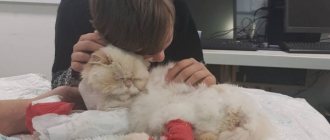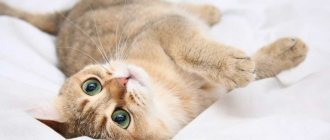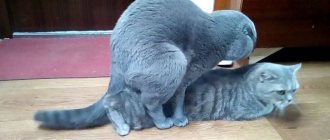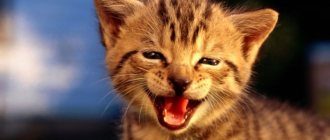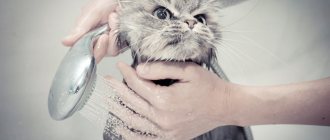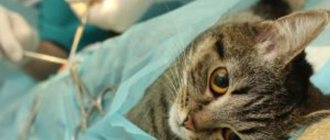Expert advice
What about hormonal drugs? We haven't forgotten about them, of course. However, following the advice of veterinarians, we recommend using them only in exceptional cases. It should be understood that regular use of them causes metabolic disorders in animals. And it already manifests itself in the form:
- inflammation in the organs of the reproductive system;
- problematic pregnancy;
- weak or sick offspring;
- difficult births leading to caesarean sections;
- tumors of the mammary glands and uterus, including malignant ones.
This is why responsible specialists prefer sterilization when owners don’t want to hear about furry children. The advantages of this option for solving the problem of offspring are obvious: you save yourself and your pet from suffering, prevent the dangerous consequences of using hormonal drugs and, in the end, reduce the number of useless defenseless lumps. In addition to the usual hormonal drugs in the form of injections or tablets, there are also chips containing the hormone, which are injected subcutaneously and, if necessary, removed.
However, having decided to sterilize your pet, you should remember that before the operation, they usually need an examination by an experienced veterinarian, and after that - competent and caring care. You also need to find out what she should be vaccinated with. If everything is done professionally and with love, your cat will not be in a state of chaleur, warming the house with its love for many, many years.
Loading …
“Vulnerable” places of Scottish folds
Scottish Fold is classified as an undemanding strong breed. But every artificial species has “vulnerable” places.
What problems do owners of fold-eared cats encounter?
- Diseases of the musculoskeletal system. In adulthood, problems with the development of bone and cartilage tissue begin.
- Cats easily gain excess weight as a result of a sedentary lifestyle and an unbalanced diet. This gives impetus to liver and heart dysfunction, and the risk of serious problems increases.
- The ear is the weakest point of the Scottish Folds. Responsible owners of fold-eared cats regularly inspect their pets' ears and clean them of dirt and wax. Otherwise, an inflammatory process appears and enters the chronic stage.
- Long-haired cats suffer from the appearance of dense mats due to insufficient coat care. This reduces mobility and negatively affects muscle tissue throughout the body.
There are diseases that are most often inherited by Folds.
What diseases do cat owners face:
- Osteochondrodysplasia. Health problems can be identified by lameness and hardening of the tail.
- Osteoarthritis is joint stiffness.
- Hypertrophic cardiomyopathy is a problem with the functioning of the heart.
- Polycystic kidney disease.
Important! If crossed incorrectly, the risk of bone problems increases.
How to make friends between a cat and a cat?
A cat and a cat usually get along well together. Often their friendship develops into a tender relationship. But the cat will most likely periodically begin to “educate” the cat - by hissing, expulsion from the rest area
It is important to feed the cat and the cat separately - after all, the cat often leaves the cat nothing to eat, proving its dominant position. As a result, the cat has extra calories, and the cat is malnourished
If the cat and cat are not breeding studs, then one of them needs to be neutered. Although cats are fertile, they go into heat without excretion (like dogs), but the cat is very persistent and resourceful during the period of sexual heat. Therefore, simply placing uncastrated animals in different rooms to prevent fertilization will not work; the cat will determine faster than the owner that the female is in heat, and if you manage to place them, you will end up with crazy screams and marks.
Castration of cats
Castration is a surgical procedure aimed at removing the gonads. Veterinarians advise castration of cats aged 8 months to 1 year.
A castrated cat stops marking territorial boundaries, his aggressive state and screams during sexual desire disappear, and the risk of developing infectious and genitourinary diseases is significantly reduced.
One of the significant disadvantages of performing an operation to remove the gonads is the development of metabolic disorders in the animal body.
There is a statement that castration leads to the onset of urolithiasis. In fact, there is no direct connection between castration and the formation of stones in the urinary system. But with metabolic disorders and obesity, this disease develops often. You can prevent obesity in a neutered cat by choosing the right diet.
Main symptoms of estrus
During the heat period, cats show less aggression than males, but some individuals can attack the owner or family members. In addition, the pets begin to scream mournfully under the door, constantly trying to slip through it in order to go in search of a mate. The chants outside the door continue both day and night. It’s especially difficult for a young family with a small child: first the cat wakes everyone up, then the baby doesn’t let them sleep, and so on in a circle.
It is not difficult to notice the first symptoms of estrus in a cat:
- the pet refuses food;
- puddles appear in the wrong places;
- some individuals often run to the toilet;
- Mucus discharge may appear from the genitals.
The cat sucks up to the owner, rubs the back of its body against the floor and pieces of furniture, and people’s legs. Rolling on the floor and squirming also indicates the onset of heat. The cat is ready to mate and is actively looking for a groom. If she walks outside on her own, after a certain time her sides will become rounded, and she will delight her owners with outbred offspring.
If mating does not occur, there is a short break after estrus, and the animal’s behavior returns to normal. After each unfulfilled sexual desire, the cat becomes more aggressive, anger towards the whole world accumulates in its body and manifests itself in attacks on people and inappropriate behavior. The animal needs help, so it is urgent to take measures to reduce the number of heats and make them less bright.
How does estrus proceed?
Estrus is manifested by a whole complex of behavioral reactions. The most striking signal of its beginning is the calling cry of the female, with which she tries to attract the male. However, estrus is not limited to just the external manifestation of sexual heat. This is a complex process that takes place in several stages, which is controlled at the hormonal level.
Periods of the estrous cycle
The estrus process in cats is divided into four stages. Each of them lasts a certain time and has its own distinctive features:
- Proestrus. This is the first stage, which lasts up to 4 days. Proestrus is characterized by restlessness. The pet rubs against interior items, becomes more affectionate, obsessively demands that the owner stroke it, and makes quiet sounds.
- Estrus. The duration of this stage is about 10 days. Estrus is indicated by louder meows. The female actively seeks a male for mating; when stroking, she presses herself to the floor, tucks her hind legs and extends her tail. If it is necessary for a female to become pregnant, she is brought together with a cat at this time.
- Metestrus. During this period, the cat's sex drive decreases. If fertilization has occurred, then she becomes indifferent to males, and sometimes even shows aggression towards them. The duration of metestrus is from 3 to 12 days.
- Anestrus. The last stage of estrus. The sexual hunt ends, the pet's behavior becomes the same.
Signs of estrus
When a female walks, you can notice this by characteristic signs. They manifest themselves most clearly in the second stage of estrus. However, the beginning of the process of sexual hunting can also be determined by some changes:
- the pet often visits the tray;
- there is a change in mood, an affectionate cat may suddenly become aggressive;
- appetite decreases and sometimes disappears completely;
- vaginal discharge appears.
High levels of hormones affect the behavior of the female. During the active phase of estrus, the following symptoms can be observed:
- Obsessive affection. The pet literally does not leave the owner, constantly rubs against his legs, and demands attention.
- Mating positions. At any touch, the cat takes a pose indicating its readiness to mate. She bends and lifts her hindquarters, extending her tail.
- Screams. Luring the cat, the female screams loudly. Screams during sexual hunting cannot be confused with anything.
- The desire to get out of the house. Following the sexual instinct, the animal strives to go outside the apartment to find a partner.
Duration of estrus in cats
The active period of estrus usually lasts from 5 to 10 days. The duration of the process depends on age, breed, season, health and living conditions. The first heat may be faster. In adult cats, hormonal levels change, which is why estrus lasts longer.
If the owner carefully observes his pet, he can accurately determine how many days the estrus lasted. In the future, the duration will remain the same. This information is necessary for breeders who breed purebred animals.
Prolonged estrus may be a sign of ovarian disease, cyst formation or tumor. An ultrasound scan at a veterinary clinic will help clarify the diagnosis and identify the problem.
Heat frequency
The average frequency of estrus in cats is from 2 to 4 times a year. The frequency of ovulation is influenced by physiology, genetics and the presence of previous pregnancies. Typically, females who have given birth walk less often. They go into heat once every 3-4 months, sometimes once every six months. After childbirth, sexual desire resumes in about a month. Cats that have not given birth ask for a cat every month. With age, the frequency of estrus decreases, it occurs faster, and the symptoms become less pronounced.
Signs that a cat is asking for a cat
The owner of a mustachioed pet can distinguish the onset of puberty by the behavior of the animal. Cats' behavior completely changes.
The main features are:
Territorial marks – sexually mature males begin to leave specific marks around the living area. These could be walls, doors, doorways, furniture. With the help of marks, the cat makes it clear to its rivals that this is its territory, and also attracts other females for mating.
Change in behavior - cats during puberty begin to show overt aggression towards their owners, as well as other animals. Aggression during the hunting season is a serious threat to owners, as the cat can scratch and even bite its breadwinner. It is worth remembering that the animal becomes practically uncontrollable and it is not possible to change its behavior using educational measures.
Screaming - using its voice, the cat tries to attract the attention of the opposite sex. Calling cries can be heard day and night, for several hours at a time
Correcting a cat's behavior with punishment is also not possible.
The desire to leave the house and run out into the street. Under the influence of hormones and the instinct to procreate, the cat will try to run out of the house, using any available means - a window or door.
The manifestation of sexual heat is also determined by a frequent urge to urinate, enlargement of the genitals and specific discharge from the penis. During the hunting period, the cat, just like a cat, loses the desire to eat. In addition, in pursuit of a female, the cats’ instinct of self-preservation is dulled.
Mr. Cat recommends: how to determine the onset of heat
The onset of puberty is marked by a combination of signs, including:
- changes in behavior from affectionate to aggressive;
- a shrill meow resembling a cry of pain;
- frequent licking of the genitals;
- increasing the frequency of trips to the toilet, marking the territory;
- decreased appetite;
- the desire to find a male in the house or outside it;
- falling on the front paws and lifting the tail;
- rolling on the floor, playfulness.
Before estrus, the cat begins to walk more, becomes gentle and demands affection.
If such symptoms are not detected until a year or later, the cause may be the so-called “erased estrus”, which is the basis for a trip to the veterinarian.
How to make friends between cats: cat and cat?
Two cats at home is a great option. Cats rarely fight over territory, with the exception of pregnant or lactating cats. In nature, female cats take up little space compared to males. They react more calmly to other cats. It is more difficult to make friends with cats when one of them is over 7 years old or has never seen other pets.
Often one of the cats becomes the leader, while the others silently agree to the “second or third role.” Dangerous moments arise when one of the cats begins a period of pregnancy, feeding kittens or sexual heat.
It happens that cats that get along well with each other suddenly begin to show aggression towards the newborn kittens of a competitor. According to cat law, this is normal. Only the mother cat should be allowed to raise newborn kittens, and it is better to isolate other cats. But it happens that if a cat, not a mother, accepts the kittens, licks them, and the mother cat reacts calmly and normally to this, then you don’t have to worry about the kittens.
But how can you make friends with cats if none of them wants to give up the role of leader? Fortunately, this rarely happens, but it causes a lot of concern. Cats fight desperately to the last. In this case, both cats need to be sterilized, otherwise it is almost impossible for the animals to hate each other. But after sterilization, aggression due to sexual instincts will disappear and there will be a chance for peace.
Adorable pictures prove that cats are cats, no matter how big they are
When you see big cats acting like house cats, you will want one as a pet. Look how many similarities there are between carnivores and their tiny domesticated cousins!
If you want to see a white tiger play with a giant ball, your wish will be granted.
Felines sit in boxes out of an instinctive desire to hide from predators. But the jaguar is a predator, so why should it sit in a cardboard box?
The answer is simple: he wants a cozy place to sleep. A cardboard box is a luxury for the jaguars at the zoo.
Like domestic cats, tigers spend about 16-20 hours sleeping and lying in the shade every day. Don't wake the tiger on his cardboard bed!
This could very well be the lion's throne, at least until the female returns with food.
This is the only ball that can withstand the sharp fangs of a tiger. Isn't Zabu an adorable big cat?
This lion seems to want to play with the photographer. How can you say no to those kitten eyes? If you can handle about 270kg of fur and claws, then you know what to do next.
Some cats will do anything to get their food. A white tiger named Mohan stands like a man to get his share of milk. Standing, he is as tall as the worker!
Cats stand to appear larger. Domestic cats try to ward off predators while standing. Big cats like Mohan most likely want to feel like they are on an equal footing with their guardian.
Amazing photo of a zookeeper giving a lion a paw massage. And he trusts the 250 kg lion so much that he is also ready to brush the mane and wash the lion.
The zookeeper has built this relationship over many years, and most people can't massage a lion that easily. Look how happy the big kitten is!
Gulena cat: all the subtleties of the process
There is an opinion that a cat wants a cat in the spring, or more precisely, in March. And it is true... in relation to the “correct” cats living “in nature”. Natural laws tell them to walk in the spring, feed their offspring in the warm season, and in the cold, think only about survival. Unfortunately or fortunately, the sleek, mustachioed pets who live in our homes look down on this opinion. A sweet life and a good diet lead to the fact that they are ready to reproduce throughout the summer and autumn months, and even winter.
At what age does a cat start asking for a cat?
What time do cats start walking? It depends on its breed: usually a cat begins to ask for a cat for the first time in the sixth to tenth month of life. However, despite the onset of puberty before the age of one year, she is not always able to give birth to healthy babies at this time. If a cat wants a cat for the first time, it is advisable not to let them meet at least until the age of one and a half years.
Signs of estrus in a tailed “bride”
What signs in an animal's behavior indicate that a cat wants a cat? There are a lot of them, and it’s difficult not to notice the signs that a cat has gone on a spree:
- the cat screams both day and night, trying to run away from the house;
- cannot stay in one place;
- cuddles up to people and rubs against objects;
- calm cats become aggressive, and vice versa;
- rolls on the floor, lifts its tail up or to the side, tramples with its hind legs, as if squatting on them;
- loses appetite or almost refuses to eat;
- noticeable discharge from the genitals;
- urination becomes more frequent.
How often does a cat ask for a cat?
How many days does a cat walk? The duration of her estrus varies from person to person. But the end of this period, when the cat has gone on a spree, does not mean at all that the owners can relax for a long time: if the “bride” did not manage to meet the “groom”, screaming and rolling on the floor can resume after a week or two. And to the question “how many days does the cat ask for the cat?” the exhausted owners answer: “all 365 in a year!” How this looks in practice, look at the video (Alexey Karasev).
How long does a cat walk?
How long does the cat ask for the cat? The duration of estrus is usually from 7 to 20 days. If the “bride” does not become pregnant, then the “wedding requirements” will be repeated every 14-21 days until she is expecting children or the resting season begins. Occasionally, a third option is also possible, the so-called false pregnancy, which postpones the appearance of a new period when the cat wants a cat.
Stages of heat
The estrus process can be roughly divided into four stages.
- The first is called proestrus. It lasts from 1 to 4 days and is characterized by the relative calm of the animal. The beginning of the period when the cat went on a spree is indicated only by quiet throaty meows and obsessive caressing of the owners. The tailed cat is not yet ready to meet a roaming cat.
- The second period, estrus, can last 7–10 days. The female begins not just to scream, but to scream at the top of her lungs. When you stroke her back, she crouches, moving her tail to the side. This means they are ready to mate. If you want to let her have a kitten or several, it is better to bring a male on the 3rd-5th day of estrus.
- In the third period, metestrus, which lasts from 3 to 12 days, the pet that has walked with the “groom” will drive away all applicants. When fertilization does not occur, a false pregnancy may begin, very similar to the real one, but not ending in childbirth. True pregnancy in your pet lasts 60–70 days.
- In the last, fourth period, called anestrus, she calms down.
How many days does a cat walk?
One of the main questions that arises for cat owners is how long do they walk? There is no clear answer to this question, since many factors influence the duration of estrus .
The duration of the period depends on:
- Age;
- Time spent without a cat;
- Living conditions;
- Environment, weather, time of year;
- Nutritional features;
- The physical condition of the cat;
- The nature of the pet's body.
In pets, estrus most often lasts from 5 to 10 days. The first estrus may be short-lived . With age, the duration increases, as the pet’s hormonal background forms and changes. In different breeds, a duration of up to 20 days can be observed.
Estrus requires constant monitoring by the breeder. You need to know how long your pet normally goes into heat.
If deviations occur and the heat lasts too long, this may indicate the presence of an ovarian cyst or tumor. A visit to the veterinarian is required to undergo an ultrasound examination.
What to do if you don't want kittens?
Fortunately, for owners, medicine has long found methods to combat the animal’s desire to procreate. After all, a cat can very often want a male if special measures are not taken. And this can be repeated for a very long time. What to do if a cat asks for a cat? We will talk about this further.
Contraception for furries
Sometimes surgery scares owners. But if a cat wants a cat, what should you do if you don’t want small pets later? Sterilization is one of the solutions in this situation. If you don’t want to let her continue to reproduce and you don’t want to listen to her constant cries from time to time, then you will need to have an operation.
If you still want offspring, then sterilization can be done after the cat gives birth. Veterinarians recommend surgery before your pet gives birth. According to experts, in this case, the pet’s hormonal levels may change, which will somehow affect its health.
But in practice, such problems are not observed so often if surgery is performed after childbirth. In addition, spayed females live much longer. They will be calmer after sterilization, and their risk of developing cancer is significantly reduced.
Sedatives
If you do not want to perform an operation, but also do not intend to listen to the animal’s cries often, then there is one more option - to give the animal a special sedative. A list of the most effective remedies is given below. But keep in mind that you can’t give them often either, only in exceptional cases.
Catnip to reduce sexual activity
- Cat Baiyun. Sold both in solution and in tablets. It makes the estrus cycle easier for your pet, but this drug can also be used in cases of stress.
- Cat mint. Sold in pharmacies and veterinary stores both in the form of bags and as a spray. There is no need to give mint to your animal. It will be enough to spray or scatter mint where the cat spends a lot of time and sleeps. This herb has a calming effect and is often used at shows, but it will also help during heat.
- Fitex drops. An excellent remedy not only for calming an animal during stress, but also for estrus. These drops contain various herbs designed to calm your pet and relieve stress.
- Stop-stress tablets or drops. This drug should be given to a cat when it screams very loudly. It is characterized by a powerful calming effect and a decrease in animal activity. According to experts, it is not addictive, so you can give it at any time.
- "Sex barrier." It is the most popular drug in this area. However, one can argue about its quality. It is not effective in all cases; apparently, it all depends on some individual factors of the body.
Frequency of cat walking
Each cat has its own cycle of “binging”: some - once every two to three months, others - once a year, very rarely - once every one and a half years. They usually “walk” for a week, plus or minus 2 days, this has an individual character. The system of estrus in cats is often hereditary.
Pedigree cats that live with a person, and therefore depend on him, may have many more estrus cycles with an interval of approximately 15-25 days.
How long does it take to walk for the first time?
The first “walking” process in a young cat’s life usually lasts 3-7 days.
Frequency depending on breed
"Getting to know" Siamese cats. (note to owners: Siamese cats have a slightly shorter pregnancy than other breeds)
If we talk about the time of onset of heat, then the St. Petersburg Sphynx, as well as cats of the Siamese, Thai, Oriental and Burmese breeds begin to “walk” earlier than representatives of other breeds. In the Scottish Fold and British Shorthair, estrus occurs less frequently than in the Persian and Siamese breeds.
What to do if a cat yells when it wants a cat?
A cat that wants a cat makes everyone in the house nervous. She screams so loudly that it is impossible to ignore her screams. Often the owners do not even manage to fall asleep. What to do in this case? There are several ways to solve the problem:
- castration;
- use of special drugs;
- mating with a cat.
The choice of method depends on the breeder's plans. If the animal is not intended to reproduce, castration is the best solution. Otherwise, unwanted symptoms can be combated with sedatives or hormonal drugs, if mating is not planned during this period.
Sedatives for cats
The safest for cats' health are sedatives. They help reduce the female's arousal and reduce the intensity of estrus symptoms. To correct your pet’s behavior, the following medications are used:
- "Cat Baiyun". Available in tablets and liquid form. It is used in cases where cats are stressed, as well as to suppress sexual heat.
- "Fitex". A sedative in drops. The medicine is based on extracts of various plants that have an anti-stress effect.
- Cat mint. The smell of this herb calms cats. It can be placed in places where the animal spends most of its time. Catnip is also available in spray form.
- "Stop stress." A powerful sedative for cats. Available in tablets and drops. The medicine quickly suppresses sexual desire and reduces the cat's activity.
Hormonal drugs: pros and cons
To eliminate the symptoms of estrus, many breeders buy hormonal medications for cats. The most popular in this group are the following:
- "Covinan";
- "Sex Barrier";
- "CounterSex Neo";
- "Stop sex."
The drugs quickly suppress natural instincts, as they change the hormonal levels in the pets’ body, but they cannot be given for a long time. According to some veterinarians, as a result of abuse of these drugs, animals develop malignant tumors in the uterus, ovaries, and mammary glands. Some cats are diagnosed with pyometra after using hormonal medications.
Castration of a cat
During castration, a female's ovaries and uterus are removed. It is no longer possible to restore reproductive function after surgery. Such cats cannot become pregnant. However, if castration was carried out during the period of estrus, then sexual desire may persist for some time after the procedure. This is due to the action of hormones that remain in the blood.
Veterinarians recommend castrating cats before their first estrus. The surgery not only prevents cat behavior, but also prevents cancer of the reproductive organs. In addition, spayed females live longer than cats that give birth.
The operation is performed under general anesthesia. Modern materials allow you to apply sutures that do not need to be removed later. For 3–5 days, the pet must be carefully monitored, its jumping and movements must be controlled so that the seams do not come apart. When the animal recovers, its behavior will be the same. The cat will never suffer from hormonal surges again.
Ways to calm your cat
The modern world is progressing, and people have come up with many ways to ease the period of estrus, both for themselves and for their pet. The most popular and accessible ones will be discussed in more detail in this section.
Drugs
How many days before vaccination should a cat be given anthelmintic?
When resorting to tablets, the owner must be aware of the risk he is putting his pet’s health at. Hormonal drugs are difficult to tolerate even by people, not to mention animals. But if you still decide to buy tablets, you should consult a veterinarian. He will help you choose the right drug, determine the quantity and dosage.
Sterilization
Today, sterilization is the safest and most humane way to make life easier for both yourself and your cat. This method is suitable for owners who do not plan to breed a cat for breeding purposes. Medicine has reached such heights that sterilization is no longer a dangerous operation. Another advantage is the increase in the life expectancy of the pet.
Important! It is best to carry out the operation before the first heat.
Cat after sterilization
By the time a cat's first heat begins, the owner must prepare. To avoid any unpleasant surprises, you need to familiarize yourself with all the information about estrus in cats. Animals live by obeying their instincts, and owners should not forget that they are responsible for those they have tamed.
How to help a cat with folk remedies during the period of wanting a cat?
There are folk remedies that can be used when a cat wants a cat, in order to use them you need to know what, you need to prepare and how to do everything.
The most well-known methods are the following:
Place the cat's rump in the water for a few minutes, keeping the water temperature relatively low. This will calm the cat down for a while.
It’s good to wet the cat so that after that she can divert her attention to licking herself. This procedure will take approximately 4 hours, so the cat will spend a lot of energy and will probably want to sleep
It is better if this action is carried out closer to night. An effective remedy is a weak vinegar solution that should be given to your pet. Veterinarians recommend masturbating the animal, imitating the cat's grip on the cat's withers. Lubricate the face with butter, which will give it the opportunity to be distracted by washing, which will also take a lot of time. Give your pet milk to drink, to which you should add soda at the tip of a teaspoon. Place a large copper plate in the container of water from which the pet drinks for the entire period. Give a closed bottle of valerian.
You can dip your cat in water to calm him down.Listed above are only the basic folk remedies that help to cope with the problem of a cat's ora during the period of wanting a cat. However, it is worth noting that they provide only a short-term effect. However, during this time, you and your pet will still be able to take a break and survive this very difficult time, as well as ease each other’s fate.
Features of mating
Ready for a date!
Cats have a closed character, and the process of fertilization is not easy for them. So, cats tend to force the male to beg himself for a long time, to run away from him, therefore, for mating, it is customary to carry the cat to the cat, and not vice versa. In addition, with such an organization of the “process”, the cat feels like a master in its territory.
Accepted, but I'll think about it some more...
Preparation for successful mating (ending with fertilization) should begin with keeping the cat with the cat for two to three days. When mating for the first time, it is better for one of the partners to be “more experienced.” When covering a cat, the male grabs the fur on the back of the cat's neck with his teeth and performs a process that usually lasts about five seconds. The signal for the end, as a rule, is a shrill cry from the female, at the same time the male jumps to the side, and she begins to ride on her back. One cat is capable of covering a cat about ten times in one hour. If several cats bred the same cat, then multiple fertilization may occur, and then each kitten may have its own father in the litter. The owner's actions during mating concern mainly the cat - the cat can be stimulated by stroking and scratching the head. Scratching under the chin, the owner holds it until the cat takes the cat by the scruff of the neck. A breeding cat can breed no more than two cats per month (one female once every two weeks).
This is a very intimate moment. There's no place for strangers here
Continuation of the cat family (features of pregnancy in cats)
The first signs of pregnancy, which lasts 9 weeks in a cat (usually from 55 to 66 days), are determined 2-3 weeks after mating by the color of the nipples - they turn pink and swell slightly. It should be noted that pregnancy in adult cats (from 3 years old) does not always have such symptoms.
There are rare cases of false pregnancy in cats, accompanied by all the signs of a normal pregnancy, but the embryo does not develop: the cat gets fat, gains weight, prepares a place for the cubs, and milk may appear. The causes of false pregnancy are purely physiological and should not be considered a pathology.
Miscarriages also occur in cats (most often at 4-5 weeks of pregnancy), which are the result of rough treatment of the animal or the presence of a uterine infection. Feline abortions have not yet been practiced anywhere.
Regulation of sexual estrus
If the cat is purebred and the owner plans to get offspring from such a cat in the future, then it is recommended to breed him with cats that have a good pedigree. In some cases, breeders advise buying a female that has previously been sterilized (ligation of appendages). The cat will be ready to mate, but in this case there will be no offspring. It will be easier for the cat to cope with his natural instincts, finding an outlet for energy.
Another method that allows you to calm a cat during the mating season is the use of special hormonal drugs. All contraceptives are designed to artificially suppress an animal's desire to mate. In addition, when taking hormonal substances, signs of sexual desire decrease.
Medications for regulating sexual desire can be of plant or hormonal origin. Hormonal drops are widely used in home practice, giving an easy and quick effect, but not long-lasting. A large number of cat lovers believe that the use of oral contraceptives for cats in the form of drops or tablets is much more humane than sterilization or castration.
There is an opinion that this is a safer method of regulating sexual desire. Veterinary experts and scientists say that tablets and drops are a time bomb. A one-time use of a hormonal drug once a year (for example, in the spring) will not harm the body.
Systematic, constant use of drops can cause serious disorders in the animal’s body, including death. This is due to the fact that contraceptives for cats contain a dose of a hormonal substance that blocks the production of physiological hormones.
Constant impact on the endocrine system leads to serious disruptions in metabolic processes, and the risk of cancer increases significantly.
Veterinarians note that even for clinically absolutely healthy cats, the drug should be used with great caution. What can we say about cats with chronic diseases?
Hormonal contraceptives for cats and cats have a pronounced progestational activity, having a negative effect on the hypothalamic-pituitary system. It is almost impossible to notice disturbances in the functioning of this part of the endocrine system in a timely manner. That is why, before you start giving your pet drops or tablets to prevent sexual desire, it is recommended to consult a professional.
The cat was left out of business
The cat is not impressed by the cat and she won’t let him near her? And this happens, the main thing is not to despair. This is not surprising, because they are characteristic. If she doesn’t like the male, then problems are guaranteed. If you are lucky and you like the cat, then it is better not to change your partner in subsequent matings. She may refuse to mate if she has problems with the uterus and ovaries. The frequency of births should not exceed 3 times every 2 years .
© shutterstock
Adviсe:
- Spread mint;
- If the process takes place in the cat’s house, it is recommended to bring the cat there a few days before so that it gets used to the new environment;
- If a cat has a difficult and aggressive character, then it is recommended to look for a cat with a similar disposition;
- Give her pills that will trigger ovulation.
At what age does a cat ask for a cat for the first time?
At a certain age, the cat’s body begins to prepare for reproduction; females begin to go into heat. At this moment, follicles mature in the ovaries. The animal's hormonal background changes. The hormone estrogen is released in large quantities, as a result of which the blood supply to the genital organs increases and clear vaginal discharge appears.
Puberty of a cat
The scientific name for estrus in cats is estrus. On average, it begins at the age of 6–8 months. However, this process is individual and depends on many factors, so in some females the first estrus occurs at 4 months, while in others the reproductive system matures closer to 12 months.
If your one-year-old cat still hasn't come into heat, she should be seen by a veterinarian. Sometimes during estrus, the pet exhibits almost no changes in behavior characteristic of sexual heat. This condition is called “erased estrus.” In this case, you also need to consult a specialist, since such conditions may indicate health problems.
If a female begins to walk, this does not mean that she is ready to reproduce. The first estrus is a symptom of the physiological maturity of the cat. Actual sexual maturity in cats is formed only at 18 months.
What determines the timing of the first estrus?
At what age does a teenage cat begin to ask for a cat depends on the individual characteristics of the body and some external conditions. The following factors have the strongest influence on puberty:
Oriental cat
- Breed. It has been found that females of some breeds reach sexual maturity at an earlier age than most domestic cats. An early onset of estrus is observed in Thai, Siamese, Burmese and Oriental cats, and St. Petersburg Sphynxes. Late maturation is often observed in females of the Persian breed, Neva Masquerade, and Maine Coons.
- Body features. More graceful and graceful females with thin bones mature faster than their stocky and large relatives.
- The time of year when the cat was born. In females that are born in winter or spring, estrus begins in spring or summer. In animals born in the summer or autumn months, maturation takes longer.
- Living conditions. Pets living in an apartment mature more slowly than outdoor cats.
- Features of temperament. Mobile active cats reach sexual maturity at an earlier date. In slow, sedentary, calm females, estrus begins later.
- Heredity. The ability to reproduce and timing of maturation also depend on genetic predisposition.
Maine Coon cats
Puberty
Males reach sexual maturity a little later than females. So, if a cat becomes ready to mate at the age of 5-6 months, then males become ready to mate from 9 to 12 months. There are cats that mature by the age of two, and this depends on many factors - diet, the presence of an animal of the opposite sex in the house, genetic characteristics.
Factors determining the period of onset of puberty:
- breed affiliation;
- skeletal structure (elegantly built pets with a fine bone structure, mature earlier than their more powerful relatives);
- season;
- habitat;
- predisposition at the genetic level.
The time when a cat matures for procreation is marked by the beginning of marks. The animal begins to mark the territory in which it considers itself the rightful owner. It is rare, but it happens that a cat does not mark the room in which it lives.
The period of intensification of sexual desire usually occurs in the spring. But cats, unlike cats, can mate all year round. This is due to the fact that males have their own specific periods of activity, depending on the individual characteristics of the body.
